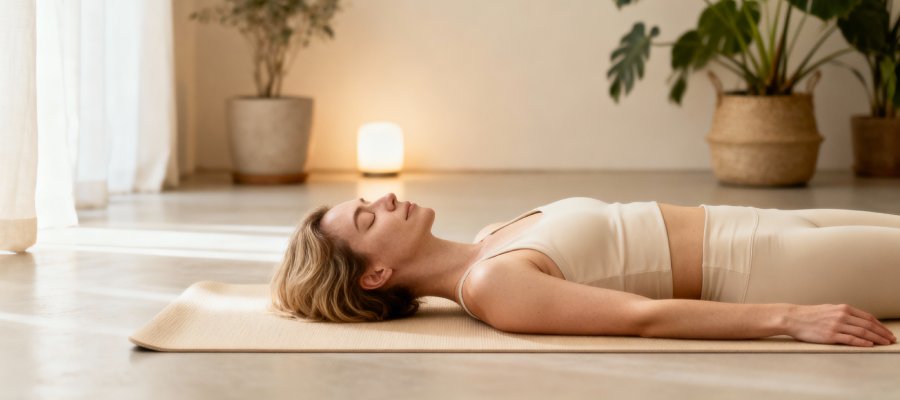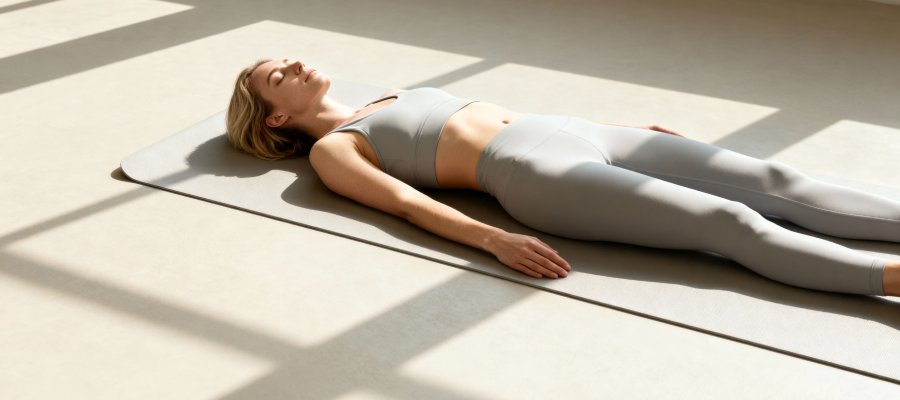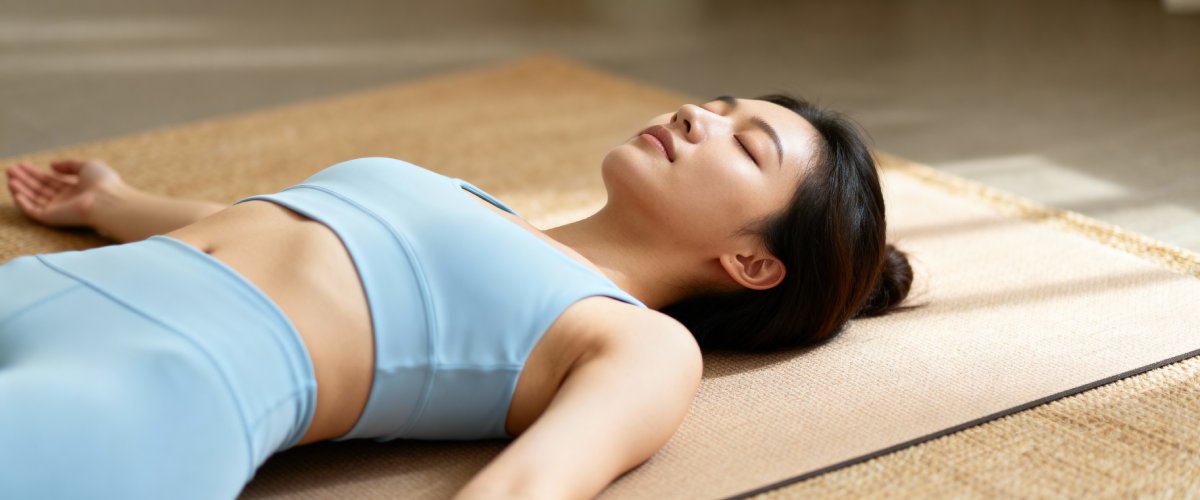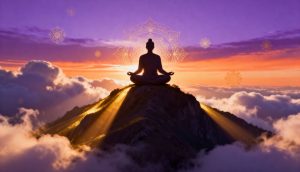Yoga Nidra, known as the yoga of conscious sleep, is a deep meditation practice performed in complete stillness. Unlike other yoga styles, it doesn’t require physical movement or complex poses; you simply need to lie down and follow specific verbal guidance.
This ancient technique takes you to a state between wakefulness and sleep where the body rests deeply while the mind remains lucid. During the approximately 45 minutes a session lasts, you experience a relaxation equivalent to several hours of restorative sleep.
The practice focuses on the systematic rotation of consciousness through the body, guided visualizations, and the establishment of a sankalpa or personal intention. This process activates the parasympathetic nervous system, facilitating cellular regeneration and hormonal balance naturally.
Contraindications of Yoga Nidra: when to avoid it or adapt the practice
Although Yoga Nidra is generally safe, there are medical situations that require special caution. Individuals with epilepsy or seizure disorders should consult their neurologist before practicing, as altered states of consciousness could trigger episodes in sensitive cases.
Active psychotic disorders, schizophrenia, or episodes of depersonalization are absolute contraindications without professional supervision. The practice can intensify disconnection from reality in these conditions. It is also recommended to avoid it during acute episodes of severe depression with suicidal ideation.

Individuals with post-traumatic stress disorder (PTSD) may experience flashbacks or relive traumas during visualizations. In these cases, it is essential to practice only with an instructor specializing in trauma who can adapt the techniques and provide adequate emotional containment.
During the first trimester of pregnancy, prolonged sessions are advised to be avoided as a precaution. After this, pregnant individuals can practice with modifications: use pillows to elevate the torso, avoid prolonged supine positions after 20 weeks, and limit sessions to 20-30 minutes.
Individuals with very low blood pressure or a tendency to faint should be cautious when standing up after practice. Deep relaxation can further lower blood pressure, causing dizziness or disorientation. It is recommended to rise slowly and remain seated for a few minutes before standing.
What Yoga Nidra is useful for in specific situations
Yoga Nidra has proven to be especially effective for chronic insomnia. Regular practice trains the nervous system to achieve states of deep relaxation, improving sleep architecture. Many practitioners report being able to fall asleep faster and experience fewer nocturnal awakenings.
In the management of chronic pain, this technique works by modifying pain perception at a neurological level. Studies show significant reductions in pain intensity in conditions such as fibromyalgia, arthritis, and migraines. Regular practice can decrease the need for analgesic medication in some cases.

Athletes use Yoga Nidra to accelerate post-training recovery. During practice, the body enters an anabolic state that promotes muscle repair and the elimination of metabolites. A 30-minute session can be as restorative as a 2-hour nap.
For anxiety management, Yoga Nidra is a powerful tool that reduces cortisol levels by up to 23% according to recent studies. Regular practice reconfigures the stress response, decreasing the reactivity of the sympathetic nervous system to everyday stressful situations.
Proven Benefits of Yoga Nidra
Neuroscientific research has documented measurable brain changes after 8 weeks of regular practice. Scans show an increase in gray matter in the hippocampus, an area related to memory and learning, and a reduction in the amygdala, the center of fear and anxiety.
On a hormonal level, regular practice balances the endocrine system remarkably. Improvements in melatonin, serotonin, and dopamine levels are observed, while cortisol and adrenaline decrease. This hormonal rebalancing positively impacts mood, sleep, and metabolism.
The immune system also benefits significantly. Studies show a 40% increase in NK (natural killer) cell activity, which are fundamental in defending against viruses and cancerous cells. Furthermore, systemic inflammation, a marker associated with multiple chronic diseases, is reduced.

Blood pressure can be reduced by 10-15 mmHg in hypertensive individuals who practice regularly. This effect is comparable to that of some antihypertensive medications, with no side effects. Heart rate variability also improves, a key indicator of cardiovascular health and longevity.
How to Safely Practice Yoga Nidra
Preparing the space is fundamental for a safe practice. You need a firm yet comfortable surface, a pleasant temperature, and a lack of interruptions. Use blankets and pillows as needed: under your knees if you have lower back pain, under your head for cervical comfort.
The ideal time to practice is between 4 and 6 PM, when the body is naturally most receptive. Avoid practicing immediately after eating or when you are very sleepy. If you practice before sleep, do so seated to avoid falling asleep during the session.
Start with short sessions of 15-20 minutes and gradually increase. It is normal to experience unusual sensations such as tingling, a feeling of floating, or changes in the perception of body size. These are normal responses of the nervous system when entering deep states of relaxation.
If during practice you experience anxiety, panic, or intense emotional discomfort, open your eyes immediately and breathe deeply. Gently move your fingers and toes to reconnect with your body. Do not force yourself to continue if you don’t feel comfortable; practice should always be enjoyable and safe.
Frequently Asked Questions about Contraindications and Safety
Can children practice Yoga Nidra? Yes, but with important adaptations. Sessions should be shorter (10-15 minutes), with simple and concrete visualizations. It is excellent for children with ADHD or sleep problems, although children under 7 may have difficulty staying still.
Is it safe to take psychiatric medication? Generally yes, but consult with your psychiatrist. Some medications can intensify relaxation or cause unusual sensations. Antidepressants and anxiolytics are compatible, but antipsychotics require special supervision during practice.
Can I practice with heart problems? Most heart conditions benefit from Yoga Nidra. However, if you have severe arrhythmias or decompensated heart failure, practice only with medical authorization. Deep relaxation can temporarily affect heart rate and blood pressure.
How long should I wait after surgery? Wait at least 6 weeks after major surgeries and 2 weeks after minor procedures. Deep relaxation can affect coagulation and healing. Start with very short sessions and gradually increase as you recover.
Can my anxiety worsen at first? Some people experience a temporary increase in anxiety during the first few sessions. This happens because the body is not used to relaxing deeply. If it occurs, practice with your eyes slightly open and reduce the practice time until you feel more comfortable.







